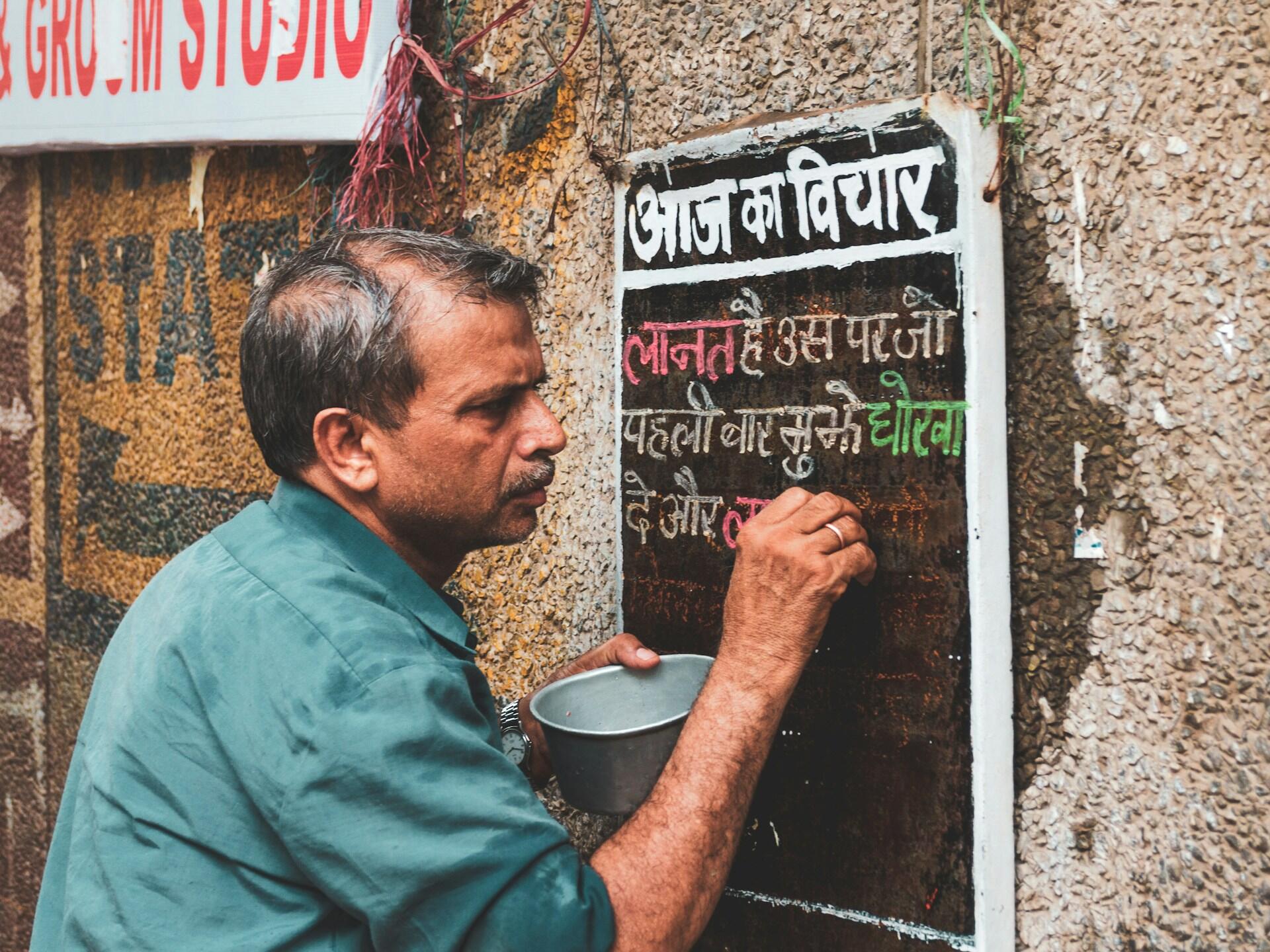Whether you want to learn Hindi for fun, to enjoy a new array of books and media, to communicate with locals on an upcoming trip, or as part of your professional career, you will need to understand the tenses. Just like in English (and most other languages), Hindi utilizes tenses in its vocabulary to indicate when events take place. Learning how tenses work in Hindi is vital for a good understanding of the language! Read on to learn how Hindi tenses work.

Why Should You Learn Hindi?
Hindi is the most spoken native language in India with more than 422 million Indian people speaking it as their first language. On top of that, another 130 million Indians speak Hindi as their second or even third language. These figures should not be surprising given that Hindi is the official language of the Indian government along with English. With a total of more than 550 million speakers, over a population of nearly 1.4 billion, Hindi is an essential medium of communication in India.
Hindi ranks third on the most spoken languages on Earth.
While not every region in India is Hindi-focused (many have their own regional languages), its use is widespread enough that knowing it is bound to be helpful wherever you are. Additionally, learning Hindi will help you develop a better ear and understanding of several other Into-Aryan languages, such as Urdu, Marathi, Punjabi, Bengali, and Gujarati.
Many of these languages share lots of words, so you will be better able to understand people in a large swath of areas, even if they speak a local language rather than Hindi.
If you are heading to India for your studies, work, or just for vacation, getting to know the local language could come in very handy, especially because India can be a very disorienting and unfamiliar territory for Westerners.
Basics of Tenses in Hindi
The first thing to realize is all the possibilities available for tenses in Hindi. There are 3 main categories of tenses in Hindi: Past, Present, and Future. And, each main category has 4 sub-types.
Present Tense
- Indefinite
- Continuous
- Perfect
- Perfect Continuous
Past Tense
- Indefinite
- Continuous
- Perfect
- Perfect Continuous
Future Tense
- Indefinite
- Continuous
- Perfect
- Perfect Continuous
The main things to remember are the big three: Present, Past, and Future. In this article, we will examine the most common sub-types of tenses within these three main types and look at Hindi tenses examples for these sub-types.
Some tense types are often referred to as “moods” in Hindi, such as the Indicative Mood and Subjunctive Mood. For today, simply focus on the Past, Present, and Future.
To conjugate verbs in Hindi, you must first identify the stem of the verb. This is pretty easy as every regular verb will end in -naa. By removing this -naa suffix, you find the stem of the verb. The number of irregular verbs is limited, so let's not worry about them for now.
Example: To read = Padhnaa ➡ Padh is the stem of the verb, and naa is the infinitive suffix.
See the example below (for a masculine subject):
| To Read - Padhana (पढ़ना) | Simple | Progressive | Perfect | Perfect Progressive |
|---|---|---|---|---|
| Present | I read - Main padhta hoon | I am reading - Main padh rahaa hoon | I have read - Main padhaa hoon | I have been reading - Main padhtaa rahaa hoon |
| Past | I read - Main padhaa | I was reading - Main padh rahaa thaa | I had read - Main padhaa thaa | I had been reading - Main padhtaa rahaa thaa |
| Future | I will read - Main padhunga | I will be reading - Main padhtaa rahunga | I will have read - Main padhaa hooungaa | I will have been reading - Main padhataa rahaa houngaa |
Refresher: Conjugating with Pronouns
Remember that Hindi requires verbs to be conjugated depending on the subject! It’s a basic feature of Hindi grammar that trips up many learners, especially English speakers.
Verbs have different endings depending if the subject is masculine or feminine. It means that each verb for each tense and each pronoun will have two forms. The feminine form nearly always ends in -ee or -en whereas the masculine form ends either in -e or -aa.
Luckily, most Hindi verbs are regular, making it easy to learn as their conjugation will follow logical and identical patterns.
One more thing to recall is the different types of “you” in Hindi. In English regardless if you are talking to your friend or the President, you will use "you.”
In Hindi "you" can have three different forms.
- "Tu" is the "you" for your loved ones and maybe your closest friends.
- "Tum" is the familiar "you" that you would use while speaking to your colleagues.
- "Aap" is the formal and respectful "you" that you would use if speaking to a stranger or a superior.


Present Tenses in Hindi
The present tense is the tense we typically use in daily life since it’s used to talk about what we are doing in the present moment. There are a few different ways to use the present tense in Hindi, just like in English.
Here are some uses of the present tenses in Hindi with examples.
You simply must learn how to conjugate the verb "to be" in Hindi, which is hona. It is used as an auxiliary verb in many instances. See the tables below to learn how to conjugate hona.
Present Simple in Hindi
A tense aims to set the action within a time frame. The present simple form is commonly used to describe an action or a fact that is true in the present, something that happens regularly, or something that is always true. In Hindi, to conjugate any verb in the present simple, you will use the auxiliary verb "to be" or "hona". See the declension below:
Verb: Hona ("to be") Conjugation in Present Tense
| English | Romanized Hindi | Devanagari |
|---|---|---|
| I am | Main hoon | मैं हूँ |
| You (intimate) are | Too hai | तू हैं |
| You (familiar) are | Tum ho | तुम हैं |
| You (formal) are | Aap hain | आप हैं |
| He / She / This is | Voh / Yeh hai | वह / वह / यह है |
| We are | Ham hain | हम हैं |
| They / That are | Ve / Ye hain | वे / वह हैं |
Also, you need to know how to form the participle of a verb.
Once you identified the stem of a verb, remove the infinitive suffix -naa and add either -taa (singular masculine), -te (plural masculine), or -tee (singular and plural feminine), this gives you the participle.
The present simple is built as follows:
👉 Stem of the verb + present participle suffix + auxiliary "hona"
For "to read" this will unfold as:
👉 I read = Padhnaa ➡ Padh + taa ➡ Main Padhtaa + hoon
Verb: Padhnaa ("to read") Conjugation in Present Tense
| English | Romanized Hindi | Devanagari |
|---|---|---|
| I read | Main Padhtaa (-ee) hoon | मैं पढ़ता हूँ |
| You (intimate) read | Too Padhtaa (-ee) hai | तू पढ़ते हैं |
| You (familiar) read | Tum Padhte (-tee) ho | तुम पढ़ते हैं |
| You (formal) read | Aap Padhte (-ee) hain | आप पढ़ते हैं |
| He / She / This reads | Voh / Yeh Padhtaa (-ee) hai | वह पढ़ता है / वह पढ़ती है. |
| We read | Ham Padhte (-ee) hain | हम पढ़ते हैं |
| They / That reads | Ve / Ye Padhte (-ee) hain | वे पढ़ते है |
Present Continous in Hindi
The present continuous is used when the action we are talking about takes place while we are talking, or to describe future plans.
The mark of the continuous tense in English, whether present, past, or future, is the suffix -ing.
In Hindi, the equivalent of -ing is the word "raha" if a subject is a masculine singular, "rahe" if the subject is masculine plural, and "rahi" if the subject is feminine (both singular and plural).
To form the present continuous in Hindi you will need to use the stem of the verb followed by the Hindi word "raha" and then add the present tense of the auxiliary "hona.”
Verb: Padhnaa ("to read") Conjugation in Present Continuous Tense
| English | Romanized Hindi | Devanagari |
|---|---|---|
| I am reading | Main Padh raha (rahi) hoon | मैं पढ़ रहा हूँ |
| You (intimate) are reading | Too Padh raha (rahi) hai | तू पढ़ रहा है |
| You (familiar) read (You are reading) | Tum Padh rahe (rahi) ho | तुम पढ़ रहे हो |
| You (formal) read (You are reading) | Aap Padh rahe (rahi) hain | आप रहे हैं |
| He / She / This reads (He / She is reading) | Voh / Yeh Padh raha (rahi) hai | वह पढ़ रहा है |
| We read (We are reading) | Ham Padh rahe (rahi) hain | हम पढ़ रहे हैं |
| They / That reads (They are reading) | Ve / Ye Padh rahe (rahi) hain | वे पढ़ रहे हैं |

Past Tenses in Hindi
To be able to conjugate in the past tenses in Hindi you will need to know the past tense of the auxiliary verb "to be" - Hona.
This verb is used to modify other verbs to turn them into actions that took place previously. In Hindi, using the verb hona in the past tense indicates that the target action took place in the past.
Learning all the tenses is necessary for building simple and complex sentences in Hindi.
Verb: Hona ("to be") Conjugation in Past Tense
| English | Romanized Hindi | Devanagari |
|---|---|---|
| I was | Main tha (thi) | मैं था / थी |
| You (intimate) were | Too tha (thi) | तू था / थी |
| You (familiar) were | Tum the (thin) | तुम थे / थीं |
| You (formal) were | Aap the (thin) | आप थे / थीं |
| He / She / This was | Voh / Yeh tha (thi) | वह पढ़ता है / वह पढ़ती है. |
| We were | Ham the (thin) | हम था / थी |
| They / That were | Ve / Ye the (thin) | वे थे / थीं |
Past Simple in Hindi
The Past Simple is used to describe an action or a fact that happened in the past, recent or not, that is finished. To form the past simple in Hindi, you need to proceed the same way you did for the present simple but rather than using the present form of the verb "hona" you will use the past tense. The form between parenthesis is the feminine conjugation.
Verb: Padhnaa ("to read") Conjugation in Past Simple Tense
| English | Romanized Hindi |
|---|---|
| I read | Main Padhtaa (-ee) tha (thi) |
| You (intimate) read | Too Padhtaa (-ee) tha (thi) |
| You (familiar) read | Tum Padhte (-tee) the (thin) |
| You (formal) read | Aap Padhte (-ee) the (thin) |
| He / She / This read | Voh / Yeh Padhtaa (-ee) tha (thi) |
| We read | Ham Padhte (-ee) the (thin) |
| They / That read | Ve / Ye Padhte (-ee) the (thin) |
The Past Continuous
The past continuous is used to describe an action that started in the past and is still happening at the time of speaking. It describes incomplete or ongoing actions. Once again, to write the past continuous form of a regular verb, simply use the same way you wrote the present continuous but replace the present tense form of the auxiliary with the past tense of "hona".
Verb: Padhnaa ("to read") Conjugation in Past Continuous Tense
| English | Romanized Hindi |
|---|---|
| I was reading | Main Padh raha (rahi) tha (thi) |
| You (intimate) were reading | Too Padh raha (rahi) tha (thi) |
| You (familiar) were reading | Tum Padh rahe (rahi) the (thin) |
| You (formal) were reading | Aap Padh rahe (rahi) the (thin) |
| He / She / This was reading | Voh / Yeh Padh raha (rahi) tha (thi) |
| We were reading | Ham Padh rahe (rahi) the (thin) |
| They / That were reading | Ve / Ye Padh rahe (rahi) the (thin) |

Future Tenses in Hindi
Now that you understand the past tenses in Hindi, we will take a closer look at the future tenses. You will need to study the Simple Future and the Future Continuous to be able to successfully describe future events or a state that is expected to happen at a later date.
The Simple Future
This tense is used for many different reasons: describing a future event, to indicate the willingness (I will) or non-willingness (I won't) of the subject, to give an order (You will!), or an invitation (Will you?).
In Hindi, this tense does not require the use of "hona" or the participle of the verb.
Instead, the Hindi conjugation uses a unique suffix for each pronoun marking the future tense. The form between parenthesis is the feminine conjugation.
Verb: Padhnaa ("to read") Conjugation in Future Tense
| English | Romanized Hindi |
|---|---|
| I will read | Main Padhunga (-ungi) |
| You (intimate) will read | Too Padhega (-ungi) |
| You (familiar) will read | Tum Padhoge (-ungi) |
| You (formal) will read | Aap Padhenge (-ungi) |
| He / She / This will read | Voh / Yeh Padhega (-ungi) |
| We will read | Ham Padhenge (-ungi) |
| They / That will read | Ve / Ye Padhenge (-ungi) |
The Future Continuous
This tense is used to describe an action or state that is expected to happen in the future but that will not be completed. In English, we use the auxiliary "to be" in the future tense form (i.e . will) and we add the suffix -ing at the end of the verb. The Hindi conjugation is rather similar as we use the future tense of the auxiliary "hona" to conjugate regular verbs.
Verb: Hona ("to be") Conjugation in Future Tense
| English | Romanized Hindi |
|---|---|
| I will read | Main hunga (hungi) |
| You (intimate) will read | Too hoga (hungi) |
| You (familiar) will read | Tum hoge (hungi) |
| You (formal) will read | Aap honge (hungi) |
| He / She / This will read | Voh / Yeh hoga (hungi) |
| We will read | Ham honge (hungi) |
| They / That will read | Ve / Ye honge (hungi) |
Verb: Padhnaa ("to read") Conjugation in Future Continuous Tense
| English | Romanized Hindi |
|---|---|
| I will read | Main Padh raha (rahi) hunga (hungi) |
| You (intimate) will read | Too Padh raha (rahi) hunga (hungi) |
| You (familiar) will read | Tum Padh rahe (rahi) hoge (hungi) |
| You (formal) will read | Aap Padh rahe (rahi) honge (hungi) |
| He / She / This will read | Voh / Yeh Padh raha (rahi) hunga (hungi) |
| We will read | Ham Padh rahe (rahi) honge (hungi) |
| They / That will read | Ve / Ye Padh rahe (rahi) honge (hungi) |
All in all, Hindi grammar is not as complicated as one might think. But, learning any new language, and especially one that is from a different language family from your mother tongue, will be tricky and will require some time and effort.
Learning about verb tenses in Hindi is a necessary step to achieve fluency. Keep on learning and practicing and you’ll be able to read, write, speak, and listen to Hindi over time!

Learn Hindi with Superprof
Learning Hindi verbs is great, but it will be useless until you gain a decent amount of vocabulary, including nouns, adjectives, and adverbs. You should also take a look at some of the most useful phrases in Hindi and check out Superprof if you wish to take Hindi lessons.
Superprof tutors are prepared to teach you whatever it is you need to know and can work with you according to your learning style. They provide lessons in-person and online so you can schedule classes anytime, anywhere according to your schedule!
When it comes to learning any language, having a tutor is the number one best resource for expanding your knowledge and practicing valuable skills like listening and speaking. Simply search on Superprof today and find your perfect tutor!
















You have save my Time thank you so much it’s very good article you explained it very well
Fruitful article for beginner. I found it essential for me.
Thanks.